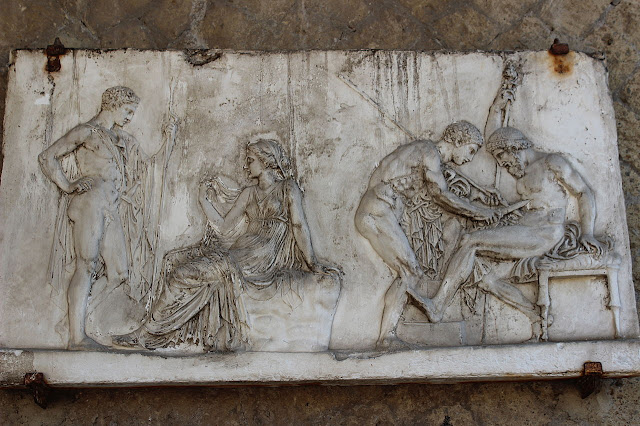In Greek mythology, Telephus (also Telephos - meaning "far-shining") was the son of Auge, a priestess of Athena who was raped by Heracles. When her father, King Aleus of Tegea learned of her violation, he attempted to dispose of mother and child. But they ended up in Asia Minor at the court of Teuthras, king of Mysia, where Telephus was adopted as the childless king's heir.
How mother and son ended up in Asia Minor is explained in a variety of versions. In the oldest extant account from a fragment of Hesiod's "Catalogue of Women, 6th century BCE, Auge goes to Mysia, is raised as a daughter by Teuthras, raped by Heracles when he arrives seeking the horses of Laomedon, and Telephus is born there. In some accounts Telephus arrives in Mysia as an infant with his mother, where Teuthras marries Auge, and adopts Telephus. In still another tale, while Auge (in various ways) is delivered to the Mysian court where she again becomes wife to the king, Telephus is instead left behind in Arcadia, having been abandoned on Mount Parthenion, either by Aleus, or by Auge when she gave birth while being taken to the sea by Nauplius to be drowned. However Telephus is suckled by a deer found and raised by King Corythus, or his herdsmen. Seeking knowledge of his mother, Telephus consulted the Delphic oracle which directed him to Mysia, where he was reunited with Auge and adopted by Teuthras.
It is this last version that found favor with Romans in Herculaneum where a fresco depicting Heracles finding Telephus suckled by a deer, with Arkadia, Pan and a winged Virgo looking on was recovered from the Augusteum and is now at the National Archaeological Museum in Naples.
Various plays were centered on the birth of Telephus including a tragedy by Sophocles entitled "Aleadae" (Sons of Aleus) and a play by Euripedes named "Auge," both of which only fragments survive. In Sophocles' play as recounted by 4th century BCE orator Alcidamas, Auge's father Aleus had been warned by the Delphic oracle that if Auge had a son, then this grandson would kill Aleus' sons, so Aleus made Auge a priestess of Athena, telling her she must remain a virgin, on pain of death. But Heracles passing through Tegea, being entertained by Aleus in the temple of Athena, became enamored of Auge and while drunk had sex with her. Aleus discovered that Auge was pregnant and gave her to Nauplius to be drowned. But, on the way to the sea, Auge gave birth to Telephus on Mount Parthenion, and according to Alcidamas, Nauplius, ignoring his orders, sold mother and child to the childless Mysian king Teuthras, who married Auge and adopted Telephus, and "later gave him to Priam to be educated at Troy". Alcidamas' version of the story must have diverged from Sophocles in at least this last respect, though. For, rather than the infant Telephus being sold to Teuthras, as in Alcidamas, an Aleadae fragment seems to infer that in the Sophoclean play, the new-born Telephus was instead abandoned (on Mount Parthenion?), where he is suckled by a deer.
It is Sophocles that includes the connection to Troy where, eventually, Telephus, was reportedly wounded by the Greek hero Achilles during the Greeks' first offensive against Troy.
"The Delphic oracle told Telephos that he could be healed only by the offending weapon. In an attempt to secure Achilles' help, he sought out Orestes, the young son of Agamemnon, and threatened to kill him. Achilles finally heeded Telephos' entreaties and furnished scrapings of his spear that healed the festering wound. - Metropolitan Museum of Art
Representations of various events of the Telephus myth have been depicted on red-figure pottery from as early as 510 BCE and east-Ionian engraved gems from about 480 BCE. As at Herculaneum, scenes showing Telephus suckled by a deer or holding Orestes hostage were particularly popular. Roman depictions of Telephus suckled by a deer were popular through the 3rd century CE.
Other scenes include either his wounding or his healing by Achilles. In the House of the Relief of Telephus, also from Herculaneum, we see a seated Telephus being healed by Achilles who scrapes rust from his spear on the festered wound.
The most complete single account of the life of Telephus is depicted in the first-century BCE Telephus frieze, a decorative relief from the Pergamon Altar produced between 180 and 156 BCE now reconstructed in the Pergamon Museum in Berlin.
 |
| Fresco from the Augusteum in Herculaneum depicting Heracles finding Telephus suckled by a deer, now in the National Archaeological Museum in Naples. |
 |
| Heracles with the infant Telephus and deer, Roman, mid second century CE at The Louvre, courtesy of Wikimedia Commons contributor Marie-Lan Nguyen. |
 |
| Terracotta lekythos (oil flask), with raised relief depicting Clytemnestra pleading with Telephos for the life of her child Orestes, Greek, late 4th century BCE at the Metropolitan Museum of Art |
 |
| Telephus threatens the infant Orestes, at Agamemnon's altar. Telephus frieze (panel 42), second century BCE from the Pergamon Altar now in Berlin at the Antikensammlung , courtesy of Wikimedia Commons contributor Marcus Cyron. |


No comments:
Post a Comment